A Spread-Spectrum Modulation Scheme for a 3 × 6 Indirect Matrix Converter Based on a Current Ripple Model
Abstract
:1. Introduction
- Through the establishment of a small-signal model on the output side, the locus of the output current ripple can be determined. Furthermore, dynamically adjusting the carrier frequency based on the ripple locus can effectively broaden the harmonic spectrum, improve total harmonic distortion, and enhance output modulation efficiency.
- The CR-SSM method dynamically adjusts the carrier frequency based on the ripple locus. The CR-SSM method is based on the output current ripple, and thus the debugging process of traditional periodic PWM is eliminated. It standardizes the construction of carrier frequencies, providing clear numerical indicators and improving frequency fluctuation efficiency. Furthermore, it reduces harmonic spikes at specific frequency bands and optimizes system efficiency.
2. Modulation Method of Multiphase IMC
2.1. Space Vector Modulation
2.2. Classical Periodic PWM
3. Spread-Spectrum Modulation Based on Current Ripple
3.1. Output Voltage Error Locus
3.2. Small-Signal Model
- The attenuation ratio for high-order harmonics should be no less than 26 dB;
- The gain of the seventh and lower-order harmonics must be limited to 2 dB;
- The voltage drop in the inductor must not exceed 3% of the fundamental amplitude;
- Reactive current flowing into the capacitor shall not exceed 20% of the rated current;
- The loss on the Rf is less than 1% of the rated power.
3.3. Current Ripple Model
3.4. Spread-Spectrum Modulation Based on Current Ripple Vectors
4. Experimental Results
4.1. Analysis of Harmonic Suppression
- The strategy of periodic PWM to reduce the carrier frequency always results in a lower range of carrier frequencies compared to the CR-SSM method while maintaining the same limit on output current ripple. It can be seen that the classical periodic PWM still has harmonic spikes near the carrier frequency of 10 kHz, the variable band energy is still more concentrated, and the THD value is higher. The proposed CR-SSM method has better spectral characteristics, no harmonic spikes at specific frequencies, uniform high-frequency energy distribution, and better THD values.
- The carrier frequency waveform displays periodicity along the direction of the output voltage vector angle , but its locus is affected by the input frequency , and it does fully coincide with the previous cycle after a complete cycle ( = 2π).
4.2. Experimental Analysis of the Converter Efficiency
- The efficiency of the CR-SSM method is always lower than that of the periodic PWM method at different voltage transmission ratios q;
- As the voltage transfer ratio q increases, the efficiency of the system also increases.
4.3. Experimental Results on Input–Output Waveform Quality
5. Conclusions
Author Contributions
Funding
Data Availability Statement
Conflicts of Interest
References
- Wang, R.; Lin, Z.; Du, J.; Wu, J.; He, X. Direct sequence spread spectrum-based PWM strategy for harmonic reduction and communication. IEEE Trans. Power Electron. 2016, 32, 4455–4465. [Google Scholar] [CrossRef]
- Raghuram, M.; Chauhan, A.K.; Singh, S.K. High-Gain-Integrated Switched Capacitor Indirect Matrix Converter. IEEE J. Emerg. Sel. Top. Power 2019, 3, 1846–1853. [Google Scholar] [CrossRef]
- Shi, T.; Wang, Z.; Ma, C.; Yan, Y.; Song, P. A Variable Switching Frequency PWM Method for Indirect Matrix Converters. In Proceedings of the 10th International Conference on Power Electronics, Machines and Drives (PEMD 2020), Online Conference, 15–17 December 2020; pp. 943–948. [Google Scholar]
- Padhee, V.; Sahoo, A.K.; Mohan, N. Modulation techniques for enhanced reduction in common-mode voltage and output voltage distortion in indirect matrix converters. IEEE Trans. Power Electron. 2016, 32, 8655–8670. [Google Scholar] [CrossRef]
- Nguyen, H.N.; Lee, H.H. An effective SVM method for matrix converters with a superior output perfor-mance. IEEE Trans. Ind. Electron. 2017, 65, 6948–6958. [Google Scholar] [CrossRef]
- Empringham, L.; Kolar, J.W.; Rodriguez, J.; Wheeler, P.W.; Clare, J.C. Technological Issues and Industrial Application of Matrix Converters: A Review. IEEE Trans. Ind. Electron. 2013, 60, 4260–4271. [Google Scholar] [CrossRef]
- Chen, J.; Sha, D.; Zhang, J. Current ripple prediction and DPWM-based variable carrier frequency control for full ZVS range three-phase inverter. IEEE Trans. Ind. Electron. 2020, 68, 1412–1422. [Google Scholar] [CrossRef]
- Casadei, D.; Serra, G.; Tani, A.; Zarri, L. Optimal use of zero vectors for minimizing the output current distortion in matrix converters. IEEE Trans. Ind. Electron. 2008, 56, 326–336. [Google Scholar] [CrossRef]
- Casadei, D.; Serra, G.; Tani, A.; Zarri, L. Theoretical and experimental analysis for the RMS current ripple minimization in induction motor drives controlled by SVM techniqu. IEEE Trans. Ind. Electron. 2004, 51, 1056–1065. [Google Scholar] [CrossRef]
- Attia, H.; Freddy, T.; Che, H.; Hew, W.; Elkhateb, A. Confined band variable carrier frequency pulse width modulation (CB-VSF PWM) for a single-phase inverter with an LCL filter. IEEE Trans. Power Electron. 2016, 32, 8593–8605. [Google Scholar] [CrossRef]
- Qin, X.; Zhou, B.; Wei, J.; Lei, J.; Liu, X.; Han, N. Distortion Analysis and Duty Ratio Correction Algorithm for Asymmetric Modulation of Two-Stage Matrix Converter. IEEE Trans. Ind. Electron. 2014, 62, 351–362. [Google Scholar] [CrossRef]
- Xie, L.; Ruan, X.; Zhu, H.; Lo, Y.-K. Common-Mode Voltage Cancellation for Reducing the Common-Mode Noise in DC–DC Converters. IEEE Trans. Ind. Electron. 2021, 5, 3887–3897. [Google Scholar] [CrossRef]
- Onederra, O.; Kortabarria, I.; De Alegria, I.M.; Andreu, J.; Gárate, J.I. Three-Phase VSI Optimal Switching Loss Reduction Using Variable Carrier frequency. IEEE Trans. Power Electron. 2016, 32, 6570–6576. [Google Scholar] [CrossRef]
- Marouani, K.; Baghli, L.; Hadiouche, D.; Kheloui, A.; Rezzoug, A. A New PWM Strategy Based on a 24-Sector Vector Space Decomposition for a Six-Phase VSI-Fed Dual Stator Induction Motor. IEEE Trans. Ind. Electron. 2008, 5, 1910–1920. [Google Scholar] [CrossRef]
- Gamoudi, R.; Elhak Chariag, D.; Sbita, L. A Review of Spread-Spectrum-Based PWM Techniques—A Novel Fast Digital Implementation. IEEE Trans. Power Electron. 2018, 12, 10292–10307. [Google Scholar] [CrossRef]
- Cano, J.M.; Navarro-Rodriguez, A.; Suarez, A.; Garcia, P. Variable Carrier frequency Control of Distributed Resources for Improved System Efficiency. IEEE Trans. 2018, 54, 4612–4620. [Google Scholar]
- Jamal, H.; Albatran, S.; Smadi, I. Variable carrier frequency algorithm for optimal tradeoff between switching losses and total demand distortion in grid-tied three-phase voltage-source inverter. In Proceedings of the 2016 IEEE Energy Conversion Congress and Exposition (ECCE), Milwaukee, WI, USA, 18–22 September 2016; IEEE: Piscataway, NJ, USA, 2016; pp. 1–7. [Google Scholar]
- Jiang, D.; Wang, F. Variable carrier frequency PWM for three-phase converters based on current ripple prediction. IEEE Trans. Power Electron. 2013, 28, 4951–4961. [Google Scholar] [CrossRef]
- Atamaniuk, V.; Kuznyetsov, O.; Lunkova, H. Driving the PWM-Controlled System to Monostable Behavior by Periodic Modulation of a Carrier Signal. In Proceedings of the 2022 IEEE 4th International Conference on Modern Electrical and Energy System (MEES), Kremenchuk, Ukraine, 20–22 October 2022; pp. 1–6. [Google Scholar]
- Shan, Y.; Pei, X.; Sun, T.; Zhang, M.; Zhou, P.; Jiang, D. Space spread-spectrum strategy for MMC to reduce the conducted EMI. IEEE Trans. Ind. Electron. 2021, 69, 10807–10818. [Google Scholar] [CrossRef]
- Chen, J.; Jiang, D.; Shen, Z.; Sun, W.; Fang, Z. Uniform distribution pulsewidth modulation strategy for three-phase converters to reduce conducted EMI and switching loss. IEEE Trans. Ind. Electron. 2019, 67, 6215–6226. [Google Scholar] [CrossRef]
- Li, Q.; Jiang, D.; Zhang, Y. Analysis and calculation of current ripple considering inductance saturation and its application to variable carrier frequency PWM. IEEE Trans. Ind. Electron. 2019, 34, 12262–12273. [Google Scholar]
- Chen, J.; Jiang, D.; Sun, W.; Shen, Z.; Zhang, Y. A Family of Spread-Spectrum Modulation Schemes Based on Distribution Characteristics to Reduce Conducted EMI for Power Electronics Converters. IEEE Trans. Ind. Applicat. 2020, 56, 5142–5157. [Google Scholar] [CrossRef]
- Le, D.; Choi, S. Network CM EMI Reduction Using Sinusoidal Frequency Modulated Carrier Wave Indexing. In Proceedings of the 2023 11th International Conference on Power Electronics and ECCE Asia (ICPE 2023-ECCE Asia), Jeju Island, Republic of Korea, 22–25 May 2023; Volume 38, pp. 3321–3326. [Google Scholar]
- Lumbreras, D.; Zaragoza, J.; Berbel, N.; Mon, J.; Gálvez, E.; Collado, A. Comprehensive Analysis of Hexagonal Sigma-Delta Modulations for Three-Phase High-Frequency VSC Based on Wide-Bandgap Semiconductors. IEEE Trans. Power Electron. 2021, 36, 7212–7222. [Google Scholar] [CrossRef]
- Menon, M.A.; Jacob, B. A New Space Vector Pulse Density Modulation Scheme for Two-Level Five Phase Induction Motor Drive. IEEE Trans. Ind. Electron. 2022, 69, 12077–12085. [Google Scholar]
- Huang, Y.; Xu, Y.; Zhang, W.; Zou, J. Modified Single-Edge SVPWM Technique to Reduce the Switching Losses and Increase PWM Harmonics Frequency for Three-Phase VSIs. IEEE Trans. Power Electron. 2020, 35, 10643–10653. [Google Scholar] [CrossRef]
- Ji, Z.; Cheng, S.; Li, X.; Lv, Y.; Wang, D. An Optimal Periodic Carrier Frequency PWM Scheme for Suppressing High-Frequency Vibrations of Permanent Magnet Synchronous Motors. IEEE Trans. Power Electron. 2023, 38, 13008–13018. [Google Scholar] [CrossRef]
- Ji, Z.; Cheng, S.; Ren, Q.; Li, X.; Lv, Y.; Wang, D. The Effects and Mechanisms of Periodic-Carrier-Frequency PWM on Vibrations of Multiphase Permanent Magnet Synchronous Motors. IEEE Trans. Power Electron. 2023, 38, 8696–8706. [Google Scholar] [CrossRef]
- Chen, N.; Yu, S.; Gao, L.; Huang, Y.; Chen, R. Suppressing Interference Peak in an Active Power Filter via Periodic Carrier Frequency Modulation Based on a Spectrum Analysis Approach. IEEE Trans. Electromagn. Compat. 2019, 61, 1760–1770. [Google Scholar] [CrossRef]
- Xu, J.; Nie, Z.; Zhu, J. Characterization and Selection of Probability Statistical Parameters in Random Slope PWM Based on Uniform Distribution. IEEE Trans. Power Electron. 2021, 1, 1184–1192. [Google Scholar] [CrossRef]
- Ma, Y.; Yang, M.; Lyu, Z.; Li, S.; Xu, D. Application of Periodic Carrier Frequency Modulation for Harmonic and EMI Reduction in GaN-Based Motor Drive. In Proceedings of the 2020 23rd International Conference on Electrical Machines and Systems (ICEMS), Hamamatsu, Japan, 24–27 November 2020; pp. 778–782. [Google Scholar]
- Nguyen, T.D.; Lee, H.-H. Dual Three-Phase Indirect Matrix Converter With Carrier-Based PWM Method. IEEE Trans. Power Electron. 2014, 2, 569–581. [Google Scholar] [CrossRef]
- Benson, M.; Dornala, A.; Andleeb, M.; Lee, K.; Lee, W. Simple and Robust Carrier-Based PWM Technique for Single-Stage Three-phase Rectifier Indirect Matrix Converter. In Proceedings of the 2024 IEEE Applied Power Electronics Conference and Exposition (APEC), Long Beach, CA, USA, 25–29 February 2024; pp. 691–697. [Google Scholar]
- Park, H.P.; Kim, M.; Jung, J.H. Spread spectrum technique to reduce EMI emission for an LLC resonant converter using a hybrid modulation method. IEEE Trans. Power Electron. 2017, 33, 3717–3721. [Google Scholar] [CrossRef]
- Dasgupta, A.; Sensarma, P. Filter design of direct matrix converter for synchronous applications. IEEE Trans. Ind. Electron. 2014, 61, 6483–6493. [Google Scholar] [CrossRef]
- Qiu, Z.; Chen, Y.; Kang, Y.; Liu, X.; Gu, F. Investigation into periodic signal-based dithering modulations for suppression sideband vibro-acoustics in PMSM used by electric vehicles. IEEE Trans. Energy Convers. 2020, 36, 1787–1796. [Google Scholar] [CrossRef]
- Leoncini, M.; Bertolini, A.; Melillo, P.; Gasparini, A.; Levantino, S.; Ghioni, M. Spread-spectrum frequency modulation in a DC/DC converter with time-based control. IEEE Trans. Power Electron. 2022, 38, 4207–4211. [Google Scholar] [CrossRef]
- Kumar, A.B.; Narayanan, G. Variable-Carrier frequency PWM Technique for Induction Motor Drive to Spread Acoustic Noise Spectrum with Reduced Current Ripple. IEEE Trans. Ind. Appl. 2016, 52, 3927–3938. [Google Scholar] [CrossRef]
- Li, Q.; Jiang, D. Variable Carrier frequency PWM Strategy of Two-Level Rectifier for DC-Link Voltage Ripple Control. IEEE Trans. Power Electron. 2017, 33, 7193–7202. [Google Scholar] [CrossRef]
- Xu, C.; Lu, S. Practical Online Modulation Method for Current Ripple and Switching Losses Reduction in the Three-Phase Voltage Source Inverters. IEEE Trans. Power Electron. 2021, 2, 1475–1490. [Google Scholar] [CrossRef]

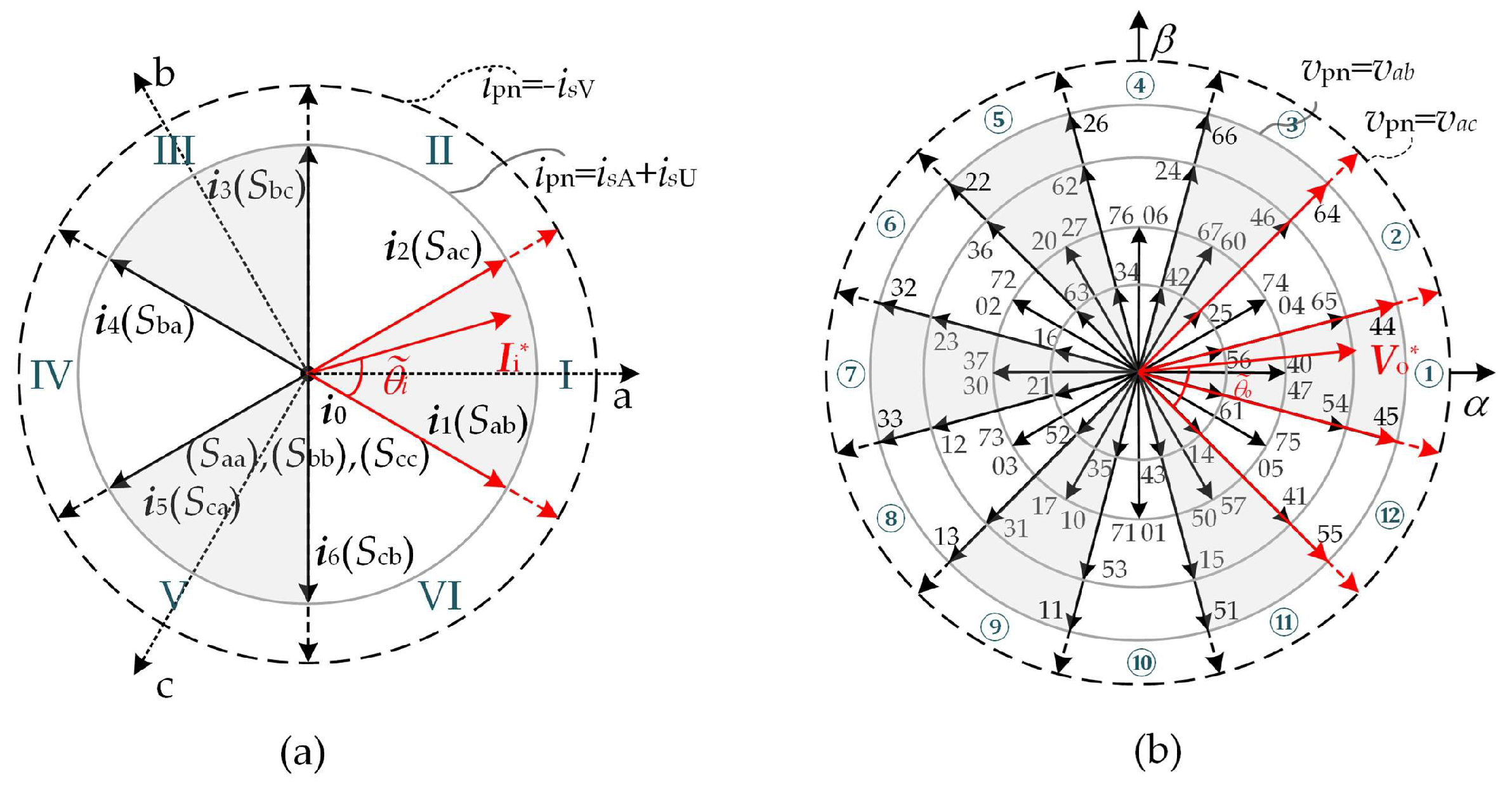

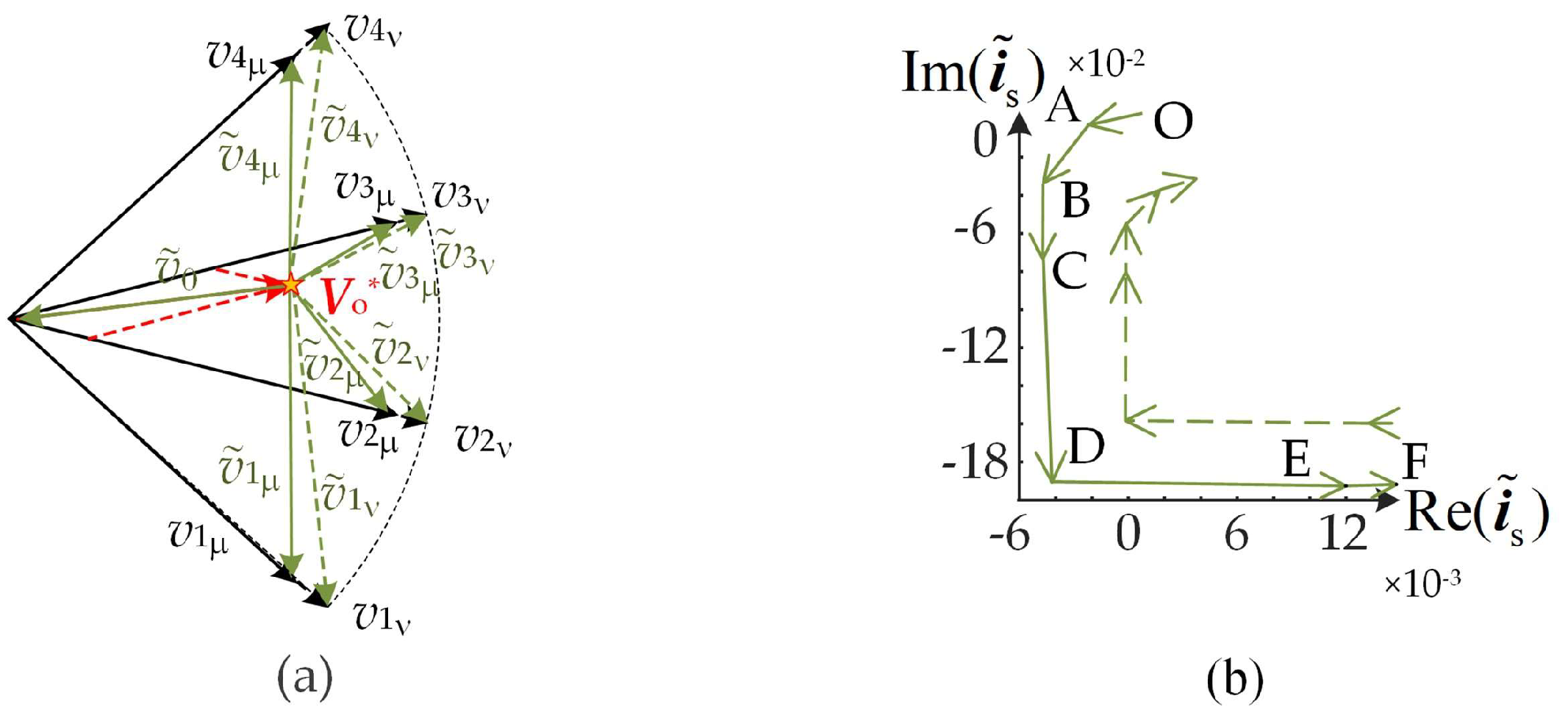
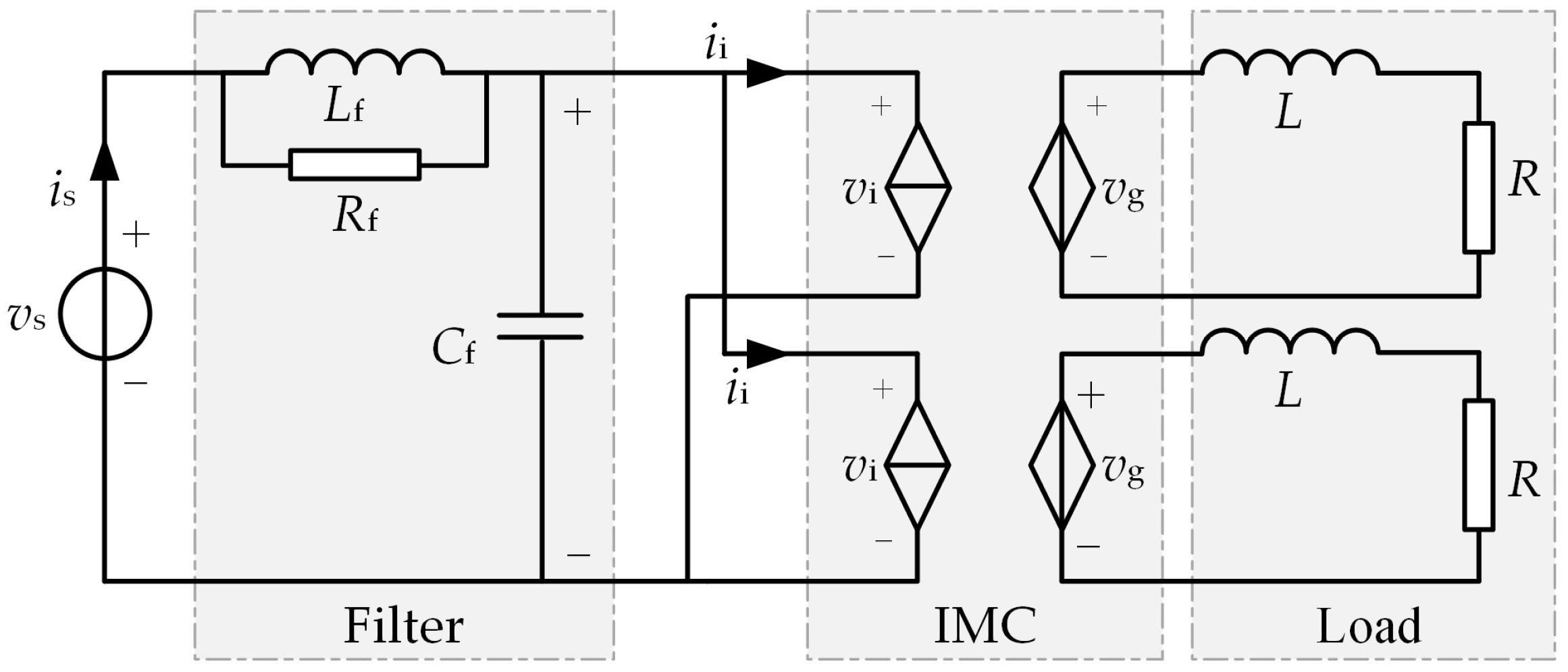
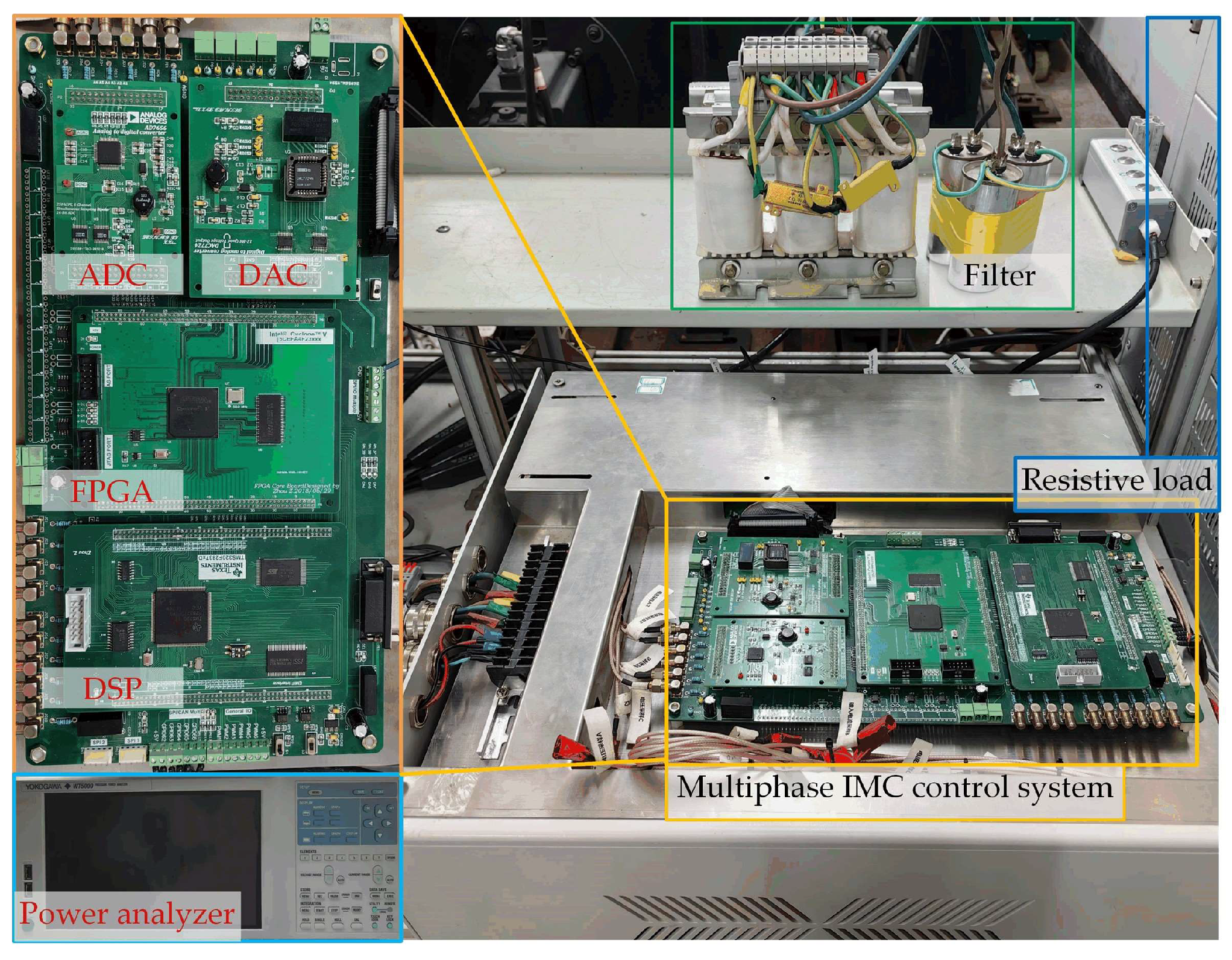



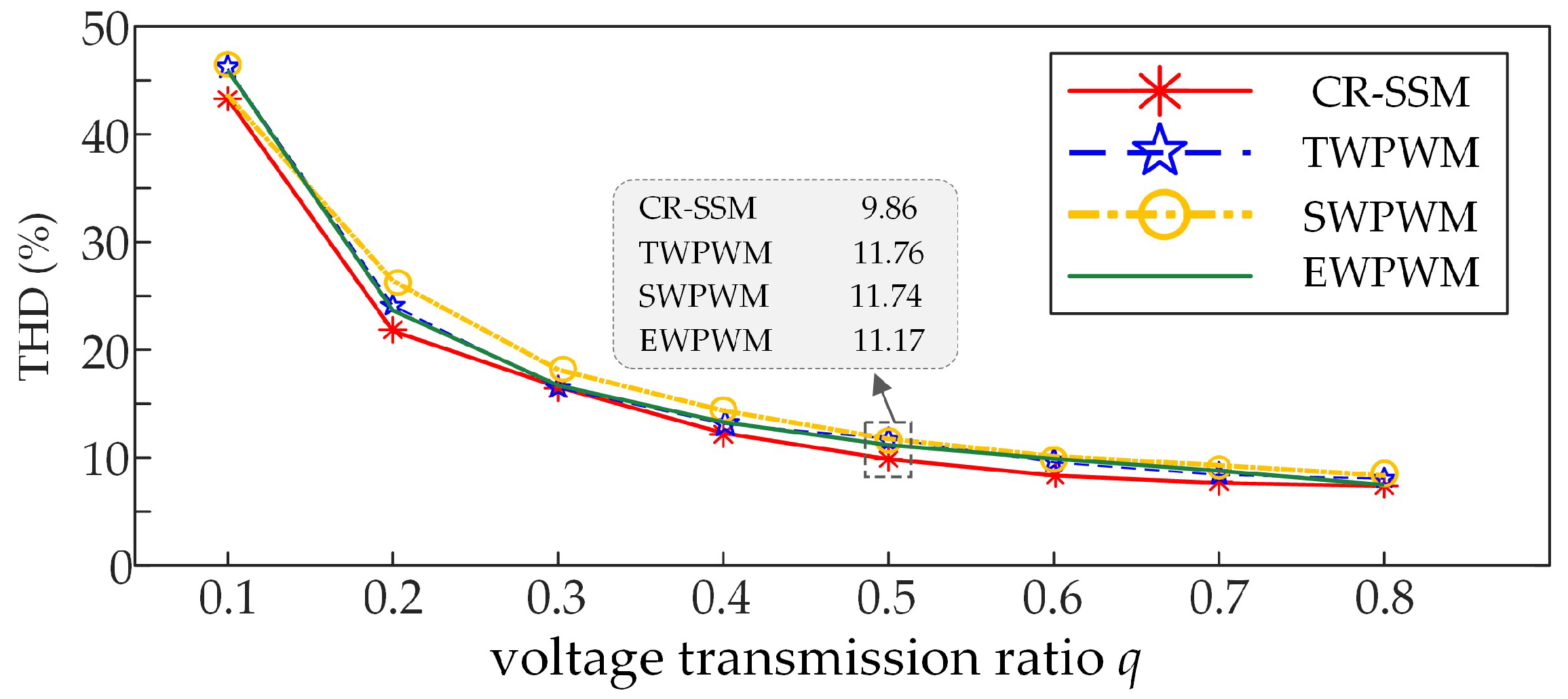


| Sec ① | Sec ② | Sec ⑤ | Sec ⑥ | Sec ⑨ | Sec ⑩ | |
| V0 | 00 | 00 | 00 | 00 | 00 | 00 |
| V2 | 45 | 44 | 26 | 22 | 13 | 11 |
| V1 | 55 | 45 | 66 | 26 | 33 | 13 |
| V7 | 77 | 77 | 77 | 77 | 77 | 77 |
| V4 | 64 | 66 | 32 | 33 | 51 | 55 |
| V3 | 44 | 64 | 22 | 32 | 11 | 51 |
| V7 | 77 | 77 | 77 | 77 | 77 | 77 |
| Sec ③ | Sec ④ | Sec ⑦ | Sec ⑧ | Sec ⑪ | Sec ⑫ | |
| V0 | 00 | 00 | 00 | 00 | 00 | 00 |
| V1 | 44 | 64 | 22 | 32 | 11 | 51 |
| V2 | 64 | 66 | 32 | 33 | 51 | 55 |
| V7 | 77 | 77 | 77 | 77 | 77 | 77 |
| V3 | 66 | 26 | 33 | 13 | 55 | 45 |
| V4 | 26 | 22 | 13 | 11 | 45 | 44 |
| V7 | 77 | 77 | 77 | 77 | 77 | 77 |
| Parameters | Symbol | Values |
|---|---|---|
| Effective value of grid-side phase voltage | Vs | 100 V |
| Grid-side voltage frequency | fs | 50 Hz |
| Grid-side filter capacitors | Cf | 35 μF |
| Grid-side filter inductors | Lf | 1.37 mH |
| Grid-side filter resistors | Rf | 10 Ω |
| Load resistance | R | 10 Ω |
| Load inductance | L | 30 mH |
| Output voltage frequency | fo | 20 Hz |
| Fixed carrier frequency | fc0 | 10 kHz |
Disclaimer/Publisher’s Note: The statements, opinions and data contained in all publications are solely those of the individual author(s) and contributor(s) and not of MDPI and/or the editor(s). MDPI and/or the editor(s) disclaim responsibility for any injury to people or property resulting from any ideas, methods, instructions or products referred to in the content. |
© 2024 by the authors. Licensee MDPI, Basel, Switzerland. This article is an open access article distributed under the terms and conditions of the Creative Commons Attribution (CC BY) license (https://creativecommons.org/licenses/by/4.0/).
Share and Cite
Zhou, Z.; Xue, L.; Li, C.; Geng, Q. A Spread-Spectrum Modulation Scheme for a 3 × 6 Indirect Matrix Converter Based on a Current Ripple Model. Energies 2024, 17, 2546. https://doi.org/10.3390/en17112546
Zhou Z, Xue L, Li C, Geng Q. A Spread-Spectrum Modulation Scheme for a 3 × 6 Indirect Matrix Converter Based on a Current Ripple Model. Energies. 2024; 17(11):2546. https://doi.org/10.3390/en17112546
Chicago/Turabian StyleZhou, Zhanqing, Lingyue Xue, Chen Li, and Qiang Geng. 2024. "A Spread-Spectrum Modulation Scheme for a 3 × 6 Indirect Matrix Converter Based on a Current Ripple Model" Energies 17, no. 11: 2546. https://doi.org/10.3390/en17112546






